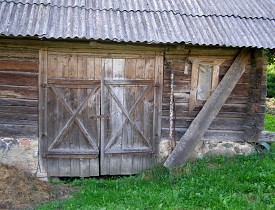Sustainable Building: Reclaimed Wood Options
 During the framing stage of homebuilding, the sight that always impresses me it the “forest” of studs and the “cloud canopy” of sheathing. Seeing a home this way really brings to mind the vast quantity of lumber that is used for its construction. Where and how this lumber is produced contribute to the home’s carbon footprint and its impact on the planet.
During the framing stage of homebuilding, the sight that always impresses me it the “forest” of studs and the “cloud canopy” of sheathing. Seeing a home this way really brings to mind the vast quantity of lumber that is used for its construction. Where and how this lumber is produced contribute to the home’s carbon footprint and its impact on the planet.
While most homes are built from “virgin” materials, there are a few alternatives out there. In most of these cases the alternatives are a bit more complex and labor intensive. Wood, by its very nature, is a renewable and sustainable building material. The trick is to balance the harvesting rate with the growth rate through managed forestry practices. Foresters have been grappling with this concept for generations. One way to reduce the “harvesting” element is through the used of “reclaimed” wood for rough carpentry work.
Types of Reclaimed Wood
- Timbers: These are some of the more common sources and can range from old agricultural barns to old urban factories and warehouses. The timbers can be re-used as timbers, or machined into lumber and find use as flooring, studs, cabinetry etc. The conversion of an old barn into home is perhaps the most dramatic. The barns timber’s provide the “bones” to the home which is often “skinned” with SIP (Structural Insulated Panels) or is “in-filled” with straw bales or other materials. Many of these old barn structures spent the first 100- 150 years protecting crops of hay…now the can provide shelter of a different sort.
- Deconstructed Lumber: While not so common with large remodel projects or new home construction, working with deconstructed lumber has two primary benefits. The first is that this “old” material is not “wasted” by heading to a landfill. The second is it reduces the need for virgin material. The use of deconstructed material does have it drawbacks. The simple task of grabbing a board off a pile and using it is easy. Using a deconstructed board may require some disassembly or removing some nails and screws. This extra step adds some labor cost, but since most deconstructed lumber is priced well below “virgin” material this can often be justified.
- Wood products: This group is a bit more diverse and can range from planks and siding, which are often re-used as planks and siding, to more unconventional sources and uses. I have read about people who have built projects from reclaimed shipping pallets. These projects have ranged from docks and decks, to sheds and small cabins or homes. Henry David Thoreau famously built his “Walden” cabin from mostly reclaimed materials. One of his driving influences for this was economy, with his own labor and the re-cycled materials his total cost of his home was $28.12. Granted the economics of 1845 vary from today, but the concept was solid, and his venture was indeed well ahead of its time.
Kevin Stevens is a Networx writer. Read more articles like this one or get help with your home projects on Networx.com.
Looking for a Pro? Call us (866) 441-6648

Remodeling Average Costs
Remodeling Contractors Experiences

Careful, Professional Tree Service Removes A Huge Norway Maple

Landscaping Turns A Weed Patch Into A Great Little Zen Garden



